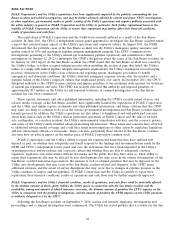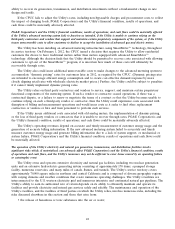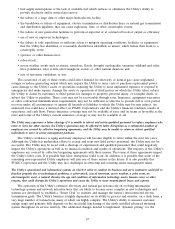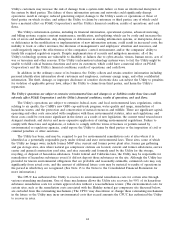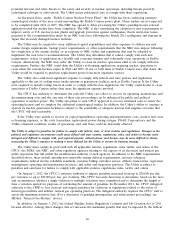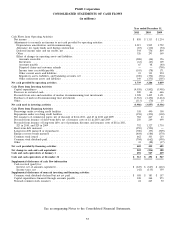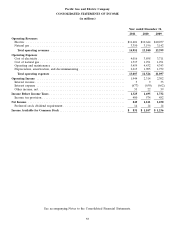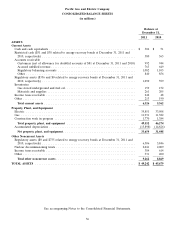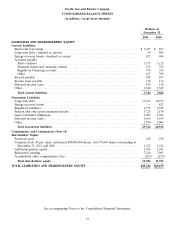PG&E 2011 Annual Report Download - page 52
Download and view the complete annual report
Please find page 52 of the 2011 PG&E annual report below. You can navigate through the pages in the report by either clicking on the pages listed below, or by using the keyword search tool below to find specific information within the annual report.recover such contributions in rates, the contributions would negatively affect PG&E Corporation’s and the Utility’s
financial condition, results of operations, and cash flows.
Other Utility obligations, such as its workers’ compensation obligations, are not separately earmarked for
recovery through rates. Therefore, increases in the Utility’s workers’ compensation liabilities and other unfunded
liabilities caused by a decrease in the applicable discount rate negatively impact net income.
PG&E Corporation’s and the Utility’s financial statements reflect various estimates, assumptions, and values; changes to
these estimates, assumptions, and values—as well as the application of and changes in accounting rules, standards, policies,
guidance, or interpretations—could materially affect PG&E Corporation’s and the Utility’s financial condition or results of
operations.
The preparation of financial statements in conformity with GAAP requires management to make estimates and
assumptions that affect the reported amounts of revenues, expenses, assets, and liabilities, and the disclosure of
contingencies. (See the discussion under Note 1 of the Notes to the Consolidated Financial Statements and the
section entitled ‘‘Critical Accounting Policies’’ above.) If the information on which the estimates and assumptions are
based proves to be incorrect or incomplete, if future events do not occur as anticipated, or if there are changes in
applicable accounting guidance, policies, or interpretation, management’s estimates and assumptions will change as
appropriate. A change in management’s estimates or assumptions, or the recognition of actual losses that differ from
the amount of estimated losses, could have a material impact on PG&E Corporation’s and the Utility’s financial
condition, results of operations, and cash flows.
As a holding company, PG&E Corporation depends on cash distributions and reimbursements from the Utility to meet its
debt service and other financial obligations and to pay dividends on its common stock.
PG&E Corporation is a holding company with no revenue generating operations of its own. PG&E
Corporation’s ability to pay interest on its outstanding debt, the principal at maturity, and to pay dividends on its
common stock, as well as satisfy its other financial obligations, primarily depends on the earnings and cash flows of
the Utility and the ability of the Utility to distribute cash to PG&E Corporation (in the form of dividends and share
repurchases) and reimburse PG&E Corporation for the Utility’s share of applicable expenses. Before it can distribute
cash to PG&E Corporation, the Utility must use its resources to satisfy its own obligations, including its obligation to
serve customers, to pay principal and interest on outstanding debt, to pay preferred stock dividends, and meet its
obligations to employees and creditors. The Utility’s ability to pay common stock dividends is constrained by
regulatory requirements, including that the Utility maintain its authorized capital structure with an average 52%
equity component. Further, the CPUC could adopt the CPSD’s financial recommendations made in its January 12,
2012 report on the San Bruno accident, including that the Utility ‘‘should target retained earnings towards safety
improvements before providing dividends, especially if the Utility’s ROE exceeds the level set in a GRC.’’
PG&E Corporation’s and the Utility’s ability to pay dividends also could be affected by financial covenants
contained in their respective credit agreements that require each company to maintain a ratio of consolidated total
debt to consolidated capitalization of at most 65%. If the Utility is not able to make distributions to PG&E
Corporation or to reimburse PG&E Corporation, PG&E Corporation’s ability to meet its own obligations could be
impaired and its ability to pay dividends could be restricted.
PG&E Corporation could be required to contribute capital to the Utility or be denied distributions from the Utility to the
extent required by the CPUC’s determination of the Utility’s financial condition.
The CPUC imposed certain conditions when it approved the original formation of a holding company for the
Utility, including an obligation by PG&E Corporation’s Board of Directors to give ‘‘first priority’’ to the capital
requirements of the Utility, as determined to be necessary and prudent to meet the Utility’s obligation to serve or to
operate the Utility in a prudent and efficient manner. The CPUC later issued decisions adopting an expansive
interpretation of PG&E Corporation’s obligations under this condition, including the requirement that PG&E
Corporation ‘‘infuse the Utility with all types of capital necessary for the Utility to fulfill its obligation to serve.’’ The
Utility’s financial condition will be affected by the amount of costs the Utility incurs in connection with its natural
gas transmission and distribution operations that it is not allowed to recover through rates, the amount of third-party
losses it is unable to recover through insurance, and the amount of penalties the Utility incurs in connection with the
pending investigations. After considering these impacts, the CPUC’s interpretation of PG&E Corporation’s obligation
under the first priority condition could require PG&E Corporation to infuse the Utility with significant capital in the
future or could prevent distributions from the Utility to PG&E Corporation, or both, any of which could materially
48


